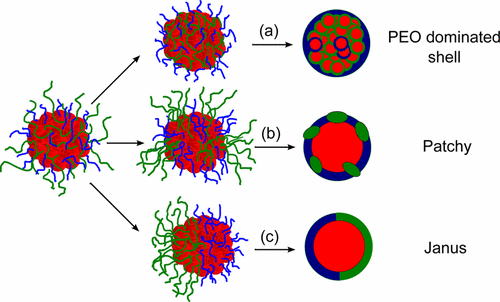Our official English website, www.x-mol.net, welcomes your
feedback! (Note: you will need to create a separate account there.)
Quest for Thermoresponsive Block Copolymer Nanoparticles with Liquid-Crystalline Surfactant Cores.
ACS Omega ( IF 3.7 ) Pub Date : 2017-09-06 , DOI: 10.1021/acsomega.7b00905 Nathalia M Carneiro 1 , Ana M Percebom 2 , Watson Loh 1
ACS Omega ( IF 3.7 ) Pub Date : 2017-09-06 , DOI: 10.1021/acsomega.7b00905 Nathalia M Carneiro 1 , Ana M Percebom 2 , Watson Loh 1
Affiliation

|
This work reports on the preparation and characterization of anisotropic composition nanoparticles based on the electrostatic binding of dodecyltrimethylammonium surfactant to poly(acrylic acid) blocks of diblock copolymers with poly(ethylene oxide) (PEO) and poly(N-isopropyl acrylamide) (PNIPAm). These nanoparticles form kinetically stable dispersions and display liquid-crystalline cores with a micellar cubic structure, as determined by small-angle X-ray scattering. Mixtures with different proportions of the two block copolymers and stoichiometric amounts of C12TA+ were prepared and their behavior was compared with that of the parent nanoparticles. Upon heating, dilute dispersions (0.01 and 0.1 wt %) analyzed by dynamic light scattering display a slight decrease in the hydrodynamic radius, consistent with the dehydration of PNIPAm and mixed PNIPAm-PEO blocks at the shell. At higher concentrations, 2 wt %, the nanoparticles with pure PNIPAm shell undergo macroscopic phase separation above 32 °C. Nanoparticles with a pure PEO shell do not display temperature sensitivity. For the mixtures, no visual change is observed, but the dynamic light scattering results evidence the formation of clusters, whose size and reversibility depend on the PEO/PNIPAm proportion. This indicates the formation of mixed nanoparticles containing both PEO and PNIPAm blocks. Nuclear Overhauser enhancement spectroscopy NMR analyses of the mixtures do not show the correlation peak expected for PEO and PNIPAm blocks in close proximity, suggesting their segregation at the nanoparticle shell. On the basis of these results, we discuss the possibilities of the neutral blocks distribution on the shell of mixed nanoparticles. Overall, we have confirmed that these nanoparticles may display a temperature-controlled reversible aggregation while preserving their internal liquid-crystalline structures.
中文翻译:

寻求具有液晶表面活性剂核心的热敏嵌段共聚物纳米颗粒。
这项工作报告了基于十二烷基三甲基铵表面活性剂与聚环氧乙烷(PEO)和聚(N-异丙基丙烯酰胺)(PNIPAm)的二嵌段共聚物的聚丙烯酸嵌段的静电结合,从而制备各向异性组合物纳米粒子的方法和表征。这些纳米颗粒形成动力学稳定的分散体,并显示出具有胶束立方结构的液晶核,这是由小角度X射线散射确定的。制备了具有不同比例的两种嵌段共聚物和化学计量的C12TA +的混合物,并将其行为与母体纳米粒子的行为进行了比较。加热后,通过动态光散射分析的稀分散液(0.01和0.1 wt%)显示出流体动力学半径略有减小,与PNIPAm和混合的PNIPAm-PEO嵌段在壳上的脱水作用一致。在较高的浓度(2 wt%)下,具有纯PNIPAm壳的纳米颗粒会在32°C以上进行宏观相分离。具有纯PEO外壳的纳米颗粒不显示温度敏感性。对于混合物,没有观察到视觉变化,但是动态光散射结果证明了团簇的形成,其大小和可逆性取决于PEO / PNIPAm的比例。这表明同时含有PEO和PNIPAm嵌段的混合纳米颗粒的形成。混合物的核Overhauser增强光谱学NMR分析没有显示出PEO和PNIPAm嵌段紧密接近的预期相关峰,表明它们在纳米颗粒壳处偏析。根据这些结果,我们讨论了混合纳米颗粒壳上中性嵌段分布的可能性。总体而言,我们已经确认这些纳米粒子在保持其内部液晶结构的同时,可能会显示出温度可控的可逆聚集。
更新日期:2017-09-06
中文翻译:

寻求具有液晶表面活性剂核心的热敏嵌段共聚物纳米颗粒。
这项工作报告了基于十二烷基三甲基铵表面活性剂与聚环氧乙烷(PEO)和聚(N-异丙基丙烯酰胺)(PNIPAm)的二嵌段共聚物的聚丙烯酸嵌段的静电结合,从而制备各向异性组合物纳米粒子的方法和表征。这些纳米颗粒形成动力学稳定的分散体,并显示出具有胶束立方结构的液晶核,这是由小角度X射线散射确定的。制备了具有不同比例的两种嵌段共聚物和化学计量的C12TA +的混合物,并将其行为与母体纳米粒子的行为进行了比较。加热后,通过动态光散射分析的稀分散液(0.01和0.1 wt%)显示出流体动力学半径略有减小,与PNIPAm和混合的PNIPAm-PEO嵌段在壳上的脱水作用一致。在较高的浓度(2 wt%)下,具有纯PNIPAm壳的纳米颗粒会在32°C以上进行宏观相分离。具有纯PEO外壳的纳米颗粒不显示温度敏感性。对于混合物,没有观察到视觉变化,但是动态光散射结果证明了团簇的形成,其大小和可逆性取决于PEO / PNIPAm的比例。这表明同时含有PEO和PNIPAm嵌段的混合纳米颗粒的形成。混合物的核Overhauser增强光谱学NMR分析没有显示出PEO和PNIPAm嵌段紧密接近的预期相关峰,表明它们在纳米颗粒壳处偏析。根据这些结果,我们讨论了混合纳米颗粒壳上中性嵌段分布的可能性。总体而言,我们已经确认这些纳米粒子在保持其内部液晶结构的同时,可能会显示出温度可控的可逆聚集。











































 京公网安备 11010802027423号
京公网安备 11010802027423号